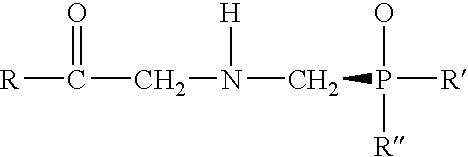Fatty acid-based herbicidal composition
a composition and fatty acid technology, applied in the field of herbicidal compositions, can solve the problems of not being able to translocate, not being suited for all applications, and many petrochemical-based herbicides considered to pose hazards to the environment, humans, animals and aquatic li
- Summary
- Abstract
- Description
- Claims
- Application Information
AI Technical Summary
Benefits of technology
Problems solved by technology
Method used
Image
Examples
example 1
[0037]Three species of weed, used in each test: Hypochoeris radicata (false dandelion), Sinapis, arvensis (wild mustard), and Avena sativa (oats), were grown in a greenhouse facility in 5.5 cm square pots using a potting soil mix comprising peat, vermiculite, sand, and 4-10-10 fertilizer. Water-soluble 20-20-20 fertilizer was used as a supplement for the plants as required. The plants were selected for use based on uniformity and quality and were potted separately. One plant per pot each of H. radicata (6–10 leaves) and S. arvensis (4–6 leaves) were used. Six to eight plants of A. sativa (2–4 leaves) were used per pot. After spraying with a herbicidal composition (as described below) the pots were arranged in a randomized complete block design in sub-irrigated watering trays. Six to ten replicates (pots) were used per treatment.
[0038]Herbicidal treatments were applied using a spray chamber fitted with a TeeJet 8006E flat fan nozzle (available from Spraying Systems Co., Wheaton, Ill....
example 2
[0041]In a greenhouse facility four plant species were grown in 5.5 cm square pots using a potting soil mix comprising peat, vermiculite, sand and 4-10-10 fertilizer. Water soluble 20-20-20 fertilizer was used as a supplement for the plants as required. The plant species used were corn, oats, radish and morningglory. The plants were selected for use based on uniformity and quality. The corn plants used were in the 3 to 4 leaf stage and two plants were present in each pot. The oats used were in the 2 to 4 leaf stage and four plants were present per pot. The radish plants used were in the 3 to 5 leaf stage and one plant was used per pot. The morningglory were in the 2 to 4 leaf stage with one plant per pot. After spraying with a herbicidal formulation, the pots were arranged in a randomized complete block design in sub-irrigated watering trays, and included a water-treated control treatment. Four replicates (pots) were used for each treatment.
[0042]Herbicidal treatments were applied a...
PUM
 Login to View More
Login to View More Abstract
Description
Claims
Application Information
 Login to View More
Login to View More - R&D
- Intellectual Property
- Life Sciences
- Materials
- Tech Scout
- Unparalleled Data Quality
- Higher Quality Content
- 60% Fewer Hallucinations
Browse by: Latest US Patents, China's latest patents, Technical Efficacy Thesaurus, Application Domain, Technology Topic, Popular Technical Reports.
© 2025 PatSnap. All rights reserved.Legal|Privacy policy|Modern Slavery Act Transparency Statement|Sitemap|About US| Contact US: help@patsnap.com

